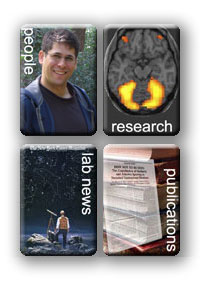
Published and In Press
Most, S.B. (2013). Inattentional blindness. In H. Pashler (Ed.), Encyclopedia of the Mind (pp.403-406). Thousand Oaks, CA: Sage Publications, Inc.
Skoranski, A., Most, S.B., Simons, R.F., Hoffman, J.E., & Hassink, S. (2013). Response monitoring and cognitive control in childhood obesity. Biological Psychology, 92, 199-204.
Wang, L, Kennedy, B.L., & Most, S.B. (2012, November 7). When emotion blinds: A spatiotemporal competition account of emotion-induced blindness. Invited contribution to Frontiers in Psychology: Special Topic on Emotion and Cognition. doi: 10.3389/fpsyg.2012.00438
Kennedy, B.L. & Most, S.B. (2012). Perceptual, not memorial, disruption underlies emotion-induced blindness. Emotion, 12, 199-202.
Bredemeier, K., Berenbaum, H., Brockmole, J.R., Boot, W.R., Simons, D.J., & Most, S.B. (2012). A load on my mind: Evidence that depression is like multi-tasking. Acta Psychologica, 139, 137-145.
Piech, R.M., McHugo, M., Smith, S.D., Dukic, M.S., Meer, J.V.D., Abou-Khalil, B., Most, S.B., & Zald, D.H. (2011). Attentional capture by emotional stimuli is preserved in patients with amygdala lesions. Neuropsychologia, 49, 3314-3319.
Bredemeier, K., Berenbaum, H., Most, S.B., & Simons, D.J. (2011). Links between neuroticism, emotional distress, and disengaging attention: Evidence from a single target RSVP task. Cognition & Emotion, 25, 1510-1519.
Most, S.B. & Wang, L. (2011). Dissociating spatial attention and awareness in emotion-induced blindness. Psychological Science, 22, 300-305.
Most, S.B. (2010). What's "inattentional" about inattentional blindness? Consciousness and Cognition, 19, 1102-1104.
Most, S.B., Laurenceau, J.-P., Graber, E., Belcher, A., & Smith, C.V. (2010). Blind jealousy? Romantic insecurity increases emotion-induced failures of visual perception. Emotion, 10, 250-256.
Moser, J.S., Most, S.B., & Simons, R.F. (2010). Increasing negative emotions by reappraisal enhances subsequent attentional control: A combined behavioral and electrophysiology study. Cognitive, Affective, and Behavioral Neuroscience, 10, 195-207.
Most, S.B. (2009). Emotional influences on perception. In E.B. Goldstein (Ed), The Sage Encyclopedia of Perception. Thousand Oaks, CA: Sage Publications, Inc.
Most, S.B. (2009). Attention and emotion. In E.B. Goldstein (Ed), The Sage Encyclopedia of Perception. Thousand Oaks, CA: Sage Publications, Inc.
Most, S.B. & Jungé, J.A. (2008). Don't look back: Retroactive, dynamic costs and benefits of emotional capture. Visual Cognition, 16, 262-278.
Most, S.B., Smith, S.D., Cooter, A.B., Levy, B.N., & Zald, D.H. (2007). The naked truth: Positive, arousing distractors impair rapid target detection. Cognition & Emotion, 21, 964-981.
Izard, C.E., Quinn, P.C., & Most, S.B. (2007). Many ways to awareness: A developmental perspective on cognitive access. [Commentary] Behavioral & Brain Sciences, 30, 506-507.
Most, S.B., Sorber, A.V., & Cunningham, J.G. (2007). Auditory Stroop reveals automatic gender associations in adults and children. Journal of Experimental Social Psychology, 43, 287-294.
Most, S.B. & Astur, R.S. (2007). Feature-based attentional set as a cause of traffic accidents. Visual Cognition, 15, 125-132.
Most, S.B., Chun, M.M., Johnson, M.R., & Kiehl, K.A. (2006). Attentional modulation of the amygdala varies with personality. NeuroImage, 31, 934-944.
Smith, S.D., Most, S.B., Newsome, L.A., & Zald, D.H. (2006). An "emotional blink" of attention elicited by aversively conditioned stimuli. Emotion, 6, 523-527.
Most, S.B., Chun, M.M., Widders, D.M., & Zald, D.H. (2005). Attentional rubbernecking: Cognitive control and personality in emotion-induced blindness. Psychonomic Bulletin & Review, 12, 654-661.
Gray, J.R., Schaefer, A., Braver, T.S., & Most, S.B. (2005). Affect and the resolution of cognitive control dilemmas. In L. Feldman Barrett, P. Niedenthal, & P. Winkielman (Eds.), Emotion and Consciousness (pp. 67-94). New York: Guilford Press.
Most, S.B., Scholl, B.J., Clifford, E., & Simons, D.J. (2005). What you see is what you set: Sustained inattentional blindness and the capture of awareness. Psychological Review, 112, 217-242.
Most, S.B., Simons, D.J., Scholl, B.J., Jimenez, R., Clifford, E., & Chabris, C.F. (2001). How not to be seen: The contribution of similarity and selective ignoring to sustained inattentional blindness. Psychological Science, 12, 9-17.
Most, S.B. & Simons, D.J. (2001). Attention capture, orienting, and awareness. In C. Folk & B. Gibson (Eds.), Attraction, Distraction, and Action: Multiple Perspectives on Attentional Capture (pp. 151-173). Amsterdam: Elsevier.
Most, S.B., Simons, D.J., Scholl, B.J., & Chabris, C.F. (2000). Sustained inattentional blindness: The role of location in the detection of unexpected dynamic events. Psyche, 6(14).
Electronic versions are provided as a professional courtesy to ensure timely dissemination of academic work for individual, noncommercial purposes. Copyright and all rights therein reside with the respective copyright holders, as stated within each paper. These files may not be reposted without permission.
